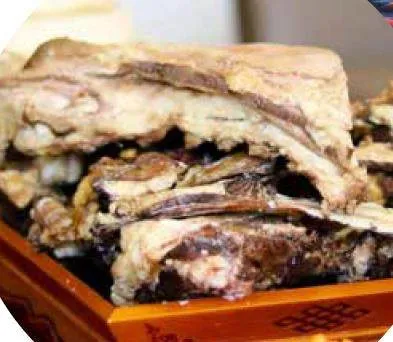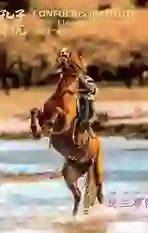草原美食情
2024-01-01赵荣光



自1 9 7 5 年起,在其后的49年间,我有近30次进入蒙古草原的经历。我幸运地结识了许多蒙古族友人、一些中外蒙古学者,还品尝了很多草原美食。
Since my first visit in1975, over the past 49 years, I’vebeen fortunate enough to travel to the Mongoliangrasslands nearly 30 times. These journeys haveintroduced me to countless Mongolian friends,as well as Chinese and international scholars ofMongolian studies. Along the way, I’ve also had thechance to savor a wide array of traditional grasslandfoods.
今天人们说起内蒙古草原饮食文化,首先想到的总是手把肉。就悠久性、普及性、醇厚性与典型性意义来说,蒙古族手把肉无疑可成代表。不过,不要误解,内蒙古草原美食不仅有手把肉,还有奶茶、羊杂汤、奶酒、奶皮子、奶油、奶疙瘩、挂面、馅饼……而且都独具魅力。
When people think about the food culture ofInner Mongolia, the first thing that often comesto mind is boiled lamb. Given its long-standinghistory, widespread appeal, rich flavor, and culturalsignificance, it’s easily the region’s most iconic dish.But Inner Mongolian cuisine is much more thanjust boiled lamb. From milk tea and lamb offal soupto fermented mare’s milk, naipizi (dry milk sheet),cream, dried Mongolian cheese, noodles, and meatpancakes, each has its unique charm.
蓝天白云,绿草黄叶,勒勒车旁,毡房坐定,一盆全羊,腾腾热气,信手利齿,笑语欢歌,那是民情融洽、朋友推心、物我同在又两忘的感觉。毡房主人的热情是温厚敦实的,他们的真诚没有任何顾虑矫饰。孩子的真诚,可爱未免天真;而成人的真诚则是人性的光辉、人格的伟大。我在许许多多个蒙古包中感受到的是集体的品格,每次躬身步入神圣的毡房都不禁心潮激荡。
Picture this: under a sky of vivid blue,surrounded by green grass and golden leaves, youfind yourself seated beside a traditional lelechecart, inside a snug felt yurt. A steaming pot ofwhole lamb is brought out, and everyone digsin — relaxed, laughing, singing, sharing stories.It’s a moment where connections deepen, and theboundary between nature and people dissolves. Thehospitality of the yurt owners is generous and sincerewithout any concern. The children’s sincerity are fullof innocence, while the adults possess a heartfeltwarmth and a nobility of spirit that is deeply moving.In countless yurts, I’ve experienced this collectivegenerosity, and every time I bow to step inside, I feela surge of emotion.
在我的心目中,手把肉不是单纯的一盘白水煮羊肉,而是能够身心感受和理解的手把肉文化。理解这种文化,就一定要深入草原,有随同放牧甚至跟从转场的体验,也就是深入草地生活。因此,不是在草地蒙古包里,不是与蒙古族牧民在牧场上呼拉尔(圆圈)围坐,手把肉的感觉会大打折扣。
To me, boiled lamb is more than just a dish. It’sa cultural experience that feeds both the body andthe soul. To truly understand its essence, you needto immerse yourself in the grasslands, walk withthe herders, and witness the rhythms of nomadiclife, including their seasonal migrations. In short,unless you’re seated in a yurt on the grasslands,or assemble (“khural” in Mongolian) withMongolian herders in a circle, the fullsignificance of boiled lamb can neverbe fully appreciated.
我第一次深入草原, 住进游牧毡房,司马迁《史记》的蒙古草原记载就生动起来,与此同时,我对“二十五史”中有关草地民族风俗的记叙有了深切的感悟。清水煮肉,是历史上游牧食生产方式决定的食生活文化,是限定条件下的可行性选择。传统游牧生活中,晚餐是一天唯一的一次正餐,牧民会例行杀一只羊。一只羊被分割成若干大块,汉语成语“大卸八块”可作形象理解。一只羊从宰杀到开吃,也就半个小时。东蒙西蒙的宰羊方法不同,以下是我在呼伦贝尔草地的一次经历:男主人在牧羊犬的配合下圈拢料理羊群,女主人在毡房外的锅灶烧水,捆倒的羊旁大小盆各一摆放,小盆中有饭碗一枚,八岁娃娃从腰间抽出解手小刀独立完成宰羊过程。在去皮、开膛和分割之后,女主人随即逐一将大块的羊肉投入近沸的水中。肉分割完毕后,娃娃将解手小刀折叠入鞘重新插回腰间,全过程熟练、轻松、利落,那神态绝不逊色于魔术师在一片掌声中的成功表演。女主人说:“巴特尔(Bater)能帮助爸爸妈妈做很多事。”而娃娃在我眼里已然是勇士。我心中暗想:“难怪蒙古旋风影响世界,英雄的民族!”娃娃宰羊的专业性,与草地生活装束、生态环境的神体雕琢,这一切都让我震撼感慨。
The first time I ventured deep into the Mongoliangrasslands and stayed in a yurt, the world describedin Sima Qian’s Records of the Grand Historian cameto life, and the customs of the grassland peoplesrecorded in the “Twenty-Four Histories” took onvivid meaning. Cooking meat in water is a foodtradition shaped by this nomadic lifestyle. In thisculture, dinner is often the only full meal of the day,usually involving the slaughter of a sheep. The animalis butchered into large chunks, which perfectlycaptures the spirit of the old Chinese idiom “cut intoeight pieces.” From the moment of slaughter to themeal on the table, the entire process takes no more than half an hour.The methods ofbutchering differbetween eastern andwestern Mongolia, butone scene stays with me.I was in Hulunbuir, watching atypical nomadic family prepare dinner. The father,with the help of herding dogs, rounded up the sheep,while the mother boiled water over an outdoorstove. Next to the sheep, two basins — one large, onesmall — sat ready, with a bowl placed in the smallerone. Their eight-year-old son pulled a small knifefrom his belt and, with surprising ease, handledthe slaughter himself. In no time, he had skinned,gutted, and divided the meat, while his motherswiftly dropped large pieces of lamb into the almostboilingwater. When he was finished, the boy foldedhis knife and tucked it back into his waistbandwith fluid, precise movements, like a magicianconcluding a trick to applause. His mother proudlyremarked, “Bater can help with many things aroundhere.” To me, this boy was already a young warrior.I thought, “No wonder the Mongols took over theworld in a whirlwind. They are all heroes!” The boy’sslaughtering skills, his attire and poise, all shaped bythe grasslands, left me in pure awe.
煮好的羊肉同样是盛在大盆里端上来的,几柄小刀随同配备,主人例行割取几片肉向天地抛祭。调料唯独盐粉,再多不过一碟草地野韭菜花酱。肋条肉最可口,讲究骨净若脱,食后毫无肉痕留存。羊肉食毕,女主人将羊汤挂面一碗恭敬端上。食毕,清台,斟酒入碗,各陈面前,酬酢间推心话语。
Once the lamb was cooked, it was served in a large basin alongside small knives for carving. Inkeeping with tradition, the host cut a few slices ofmeat and tossed them into the air as an offeringto heaven and earth. The only seasoning was salt,though there was also a small dish of wild chiveblossom sauce, a specialty of the grasslands. The ribmeat was the most flavorful, and it’s customary toeat the bones clean, leaving no trace of meat behind.Afterward, the hostess served a bowl of noodlescooked in the lamb broth, which rounded out themeal. With the table cleared, bowls of wine werepoured, and the evening ended with heartfelt toastsand conversations.
根据当地的习俗,用于款待最尊贵客人的羊通常是“二岁子”,在基因改良、科学催肥、激素促成等生物技术进入草地之前,这种羊净肉约14 斤。我与主人一家三口,一餐轻松地享用了一只羊。我还目睹过蒙古壮汉一人吃掉一只羊的景观。时任呼和诺尔书记的楚鲁(Chulu)听我说起此事还笑着说:“那有什么奇怪?我现在还能吃一只羊!”Chulu的汉语意为“石头”。楚鲁书记当时已年近五十,他性格坚强,但温和、宽厚、友善,不是一般的石头,而是温润的玛瑙石,光彩而不耀眼。他每天都喝酒,且喝白酒而非奶酒。骑着马在方圆数十里内或逾百里外巡视,经常半醺状态的他从来没有从马背上掉下来过。
In keeping with local custom, themost honored guest is served a“two-year-old lamb.” Beforethe days of gene t i cmodification, scientificf a t t e n i n g , a n dhormone-enhancedb i o t e c h n o l o g y,such a lamb wouldproduce around 7kilograms (14 jin) ofpure meat. The host, hiswife and son, and I easilyfinished eating an entirelamb in one sitting. I’veeven seen a full-grownMongolian man devoura w ho l e l amb b yhimself. Chulu, whowas the secretary ofHohonor at the time, smiled at me after hearing mywords and said, “What’s so surprising? I can still eat awhole lamb myself!” The word “chulu” means “stone”in Chinese. Chulu was nearly fifty then. He wasstrong and unyielding, but not in a rough way. Hewas more like polished agate, solid yet smooth, witha warmth that drew people in. He drank alcohol dailyand always preferred white spirits over the traditionalfermented mare’s milk. He’d often ride his horse formiles — sometimes over a hundred — conducting aninspection. Even though he was frequently in a halfdrunkenstate, he never once fell from his horse.
蒙古人习惯在腰带上斜插一把鞘上镶有银饰、玛瑙的精致佩刀,刀鞘上宽出一槽,内插约15 公分的驼鹿(犴)骨制筷子一双,称为“刀箸”。刀是劳动中割切削所需,也是用来割食的。那么那双筷子呢?草地蒙古人传统的进食方式与汉族并不完全一样,以肉为常餐食物的蒙古族是不需要筷子助食的。定居是后来的事,随着食生产与食生活方式的转变,餐具演变为风格或异而规制略同于汉族的碗筷。也就是说,刀箸中的箸并非日常餐的助食具。从文献、考古、风俗、器物、行为等多学科、多角度审视,应当说,蒙古族刀箸中的筷子主要是用来夹取热汤面的。在各类方便面流行起来之前的相当长一段时间里,挂面是蒙古族人,尤其是游牧生活的蒙古族牧民大量储备的“干粮”。挂面用白纸裹包,一斤一匝,这种“白皮挂面”既便于长期贮存,也便于挈带致远。因此,蒙古包中出现白皮挂面可以说司空见惯。对于蒙古族来说,当然,不仅仅蒙古族,还有许多处于流动状态、居于偏僻环境的少数民族,挂面无疑是他们最便捷的食粮储备,而蒙古族传统的草地“羊汤挂面”的麦、水、肉自然纯正,更是无可比拟。有理由说,是蒙古族的生产与生活方式决定了挂面的天缘需求,而挂面的大量产销也正是在元代。陆地上,游牧的草地蒙古族离不开挂面,而海上季风时节往来中国的各国船队连帆接舻,它们重要的储备粮也莫过于挂面。所以我说,中华挂面是历史上的丝绸之路食品,马可 · 波罗伴随阔阔真公主远嫁波斯的船队也是储备了大量挂面的。挂面不是蒙古族的发明,但挂面的规模生产与文化张扬确是蒙古族的贡献,挂面文化是蒙古族吃出来的,而吃羊汤挂面需要筷子。
Mongolians traditionally carried a beautifullycrafted knife, sheathed in a scabbard adorned with silver and agate, worn diagonally at the waist. Thescabbard had a groove that held a pair of chopsticks,about 15 centimeters long, made from elk bone,called the “knife and chopsticks.” The knife wasused both for cutting during work and for slicingfood. But what about the chopsticks? Unlike theHan Chinese, Mongolians didn’t traditionally usechopsticks for meals, as their diet was primarilymeat-based. It wasn’t until they settled down andtheir food production and eating habits evolved thatbowls and chopsticks became part of their diningculture, much like those of the Han people. Thechopsticks in this “knife and chopsticks” set thusweren’t for everyday meals. From a multidisciplinaryperspective — combining insights from literature,archaeology, customs, and behavioral studies — it’sclear that Mongolians primarily used chopsticks toeat hot noodles in soup. Before the era of instantnoodles, dried noodles were a staple for nomadicMongolians. These noodles, often packed in whitepaper bundles weighing about 500 grams (onecatty), were easy to store and carry over longdistances. In traditional Mongolian yurts, driednoodles were a common household item. Noodlesweren’t unique to Mongolians; many ethnic groupsliving in remote or mobile environments dependedon them for sustenance. However, the purity ofMongolian wheat, water, and meat makes Mongolian“lamb soup noodles” incomparable. It’s fair to saythat the Mongolian way of life and their productionmethods naturally gave rise to the demand for driednoodles, which began to be mass-produced duringthe Yuan Dynasty. On land, nomadic Mongoliansrelied on these noodles, while at sea, fleets travelingto China during the monsoon seasons stocked upon them as essential provisions. This is why I arguethat Chinese dried noodles were a staple along thehistoric Silk Road. Marco Polo, when travelingwith Princess Kokachin to Persia, brought largequantities of dried noodles aboard their ships.While Mongolians didn’t invent dried noodles, theirlarge-scale production and cultural significance areundoubtedly Mongolian contributions. The cultureof dried noodles grew out of the Mongolian diningexperience and eating lamb soup noodles requiredchopsticks.
所有到过内蒙古草原的人离开之际都会满心流连, 满脸依依不舍。我在草原学会了骑马,有次突然勒缰从骤停的走马头前跌倒在草地上。那一刻惊诧过后,整个身体呈“大”字型在茫茫草原上舒展开来。仰望高远天空,悠悠白云,蔚蔚青空;微风拂面,惬意舒适。朦胧中,自己似乎在被身下的无数小草合力慢慢托起,托向蓝天白云,而萦绕脑海的则是洋溢着腾腾热气的手把肉、羊汤挂面、奶茶……
Everyone who visits the Inner Mongoliangrasslands leaves with a heart full of nostalgia and areluctance to say goodbye. It was on these grasslandsthat I first learned to ride a horse. One time, afterpulling the reins a bit too sharply, the horse cameto an abrupt halt, and I went flying headfirst ontothe soft grass. After the initial shock, I found myselfsprawled out, staring up at the endless blue sky,with white clouds lazily drifting by, a gentle breezebrushing my skin, and the warm sun shining down.As sleep slowly began to overtake me, it felt as thoughthe countless blades of grass beneath me were gentlylifting me, carrying me up toward the sky and clouds.In that moment, my thoughts wandered to the flavorsof steaming boiled lamb, lamb soup noodles, andmilk tea...
